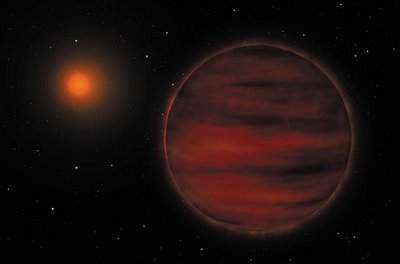 An artist's depiction of the brown dwarf (right)
An artist's depiction of the brown dwarf (right)orbiting its red star parent SCR 1845-6357. Credit: ESO.
Staff Writer
SPACE.com
Wed Mar 22, 2:00 PM ET
A team of astronomers has found a cold object that is neither star nor planet circling a star relatively close to Earth.
The object, a cool brown dwarf orbiting its red parent star, sits about 12.7 light-years from the Sun, making it the third closest such object known to date, researchers said.Cold and dim, brown dwarfs are objects that are typically massive than planets but fall short of igniting into full-fledged stars. Astronomers using the Very Large Telescope at European Southern Observatory in Paranal, Chile found the latest brown dwarf orbiting the red star SCR 1845-6357.
"Besides being extremely close to Earth, this object is a T dwarf - a very cool brown dwarf - and the only such object found as a companion to a low-mass star," said Beth Biller, lead author of the study reporting brown dwarf find and a graduate student at the University of Arizona, in a statement. "It is also likely the brightest known object of its temperature because it is so close."
The newly found brown dwarf carries a temperature of about 1,382 degrees Fahrenheit (750 degrees Centigrade) and a mass between nine and 65 times that of Jupiter, researchers said. It also orbits its red parent at a distance 4.5 times that of the average separation between Earth and the Sun, or about 418 million miles (672 million kilometers), they added.
The research will be detailed in an upcoming issue of the Astrophysical Journal.
Despite their proximity, the red star and brown dwarf observed by Biller and her colleagues is not the closest to Earth. Two others have been found around the star Epsilon Indi, which sits about 11.8 light-years from Earth. Another object sits slightly further out, at a distance of about 13 light-years, followed by another brown dwarf 16 light-years from Earth.
One light-year is the distance light travels in one year, about 5.88 trillion miles (9.7 trillion kilometers). The nearest star to Earth is Proxima Centauri 4.2-light-years away.
Biller and her team hope their brown dwarf will help astronomers better understand the cold objects that seem to occupy a purgatory between stellar and planetary formation.
Last year, researchers found a brown dwarf surrounded by a disk of material, hinting that the odd objects could spawn their own system of mini-worlds.
Markus Kasper, an ESO team member who participated in the recent brown dwarf study, said the new find allows astronomers to pin down the object's brightness and - after further observations - its precise mass.
"These properties are vital for understanding the nature of brown dwarfs," Kasper said.



No comments:
Post a Comment